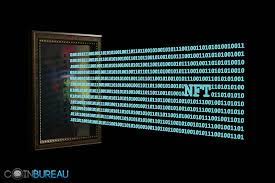What is NTF?
NFT is a blockchain technology gradually entering our lives, more
increasingly related to contemporary state-of-the-art artwork that can be
purchased at international art auctions. Non-fungible token (NFT) is a
key part of the blockchain economy. This is a type of cryptographic token that is
stored on a blockchain architecture. It is a unique, digital certificate that
provides certain ownership rights in an asset and it is not possible to copy it.
Each of the tokens is individual, of different value and has no equivalent for
itself. The most common standard for creating and issuing tokens is ERC-20, but
there are other standards in operation (e.g., ERC-223, ERC-721, ERC-777, and
ERC-1155). Each successive standard is created with increased security and
speed in mind. NFTs can be used to represent items such as photos, videos,
audio, and other types of digital files.
Blockchain is a decentralized database used to store and transmit
information about transactions made on the Internet. One of the features of
NFTs is that it can only be bought, sold and traded as individual assets and
this is one of their differentiators in the market.
The Cryptocurrency market is growing at an accelerated rate and NFT trading is definitely following it. NFTs differ from cryptocurrencies such as Bitcoin, Ethereum or DDKoin in that they are both not interchangeable and not identical. In addition, owning a given token does not entitle us to the rights reflected by the token. NFTs can’t be divided into parts as the elementary unit here is the token itself, whereas fungible tokens can be because all the units have the same value. It does not matter which unit you get.
How to mint NFT?
Creating and saving NFT for the first time on a block chain involves
minting. This is how the digital art becomes a part of Ethereum blockchain.
Thanks to this process artists can purchase, trade and track in the market the
art works. Minters may be the creator of
the work associated with the NFT, such as the artist. It can also be someone
who has the appropriate rights to mint NFT digital assets. NFT contains unique
identifier (called also ‘TokenID’), the blockchain wallet address of current
owner and an identifier of where the digital work may be found. Transactions
are fully transparent, so anyone can view an NFT and its underlying
information, including the blockchain address of the current owner and the
blockchain address of any previous owner. In addition, since transactions on a
blockchain are publicly viewable, buyers can see the address from which the NFT
was first minted.
NFT and cats?
Early forms of NFTs have been around since the mid-2010s. The NFT technology gained popularity in 2017 with the virtual cat-trading game called CryptoKitties. Namely, this is a game on Ethereum developed by Canadian studio Dapper Labs which allows players to adopt and trade virtual cats. Each cat is one-of-a-kind and 100% owned by the owner and it cannot be replicated, taken away, or destroyed. Then NFT gained momentum. Many people have used the game as a way to earn big amounts of money quick. According to the TechCrunch website research from 2017, about $1.3M has been transacted, with multiple kittens selling for ~50 ETH (around $23,000) and the “genesis” kitten being sold for a record ~246 ETH (around $113,000).
The first 5000 days
More




